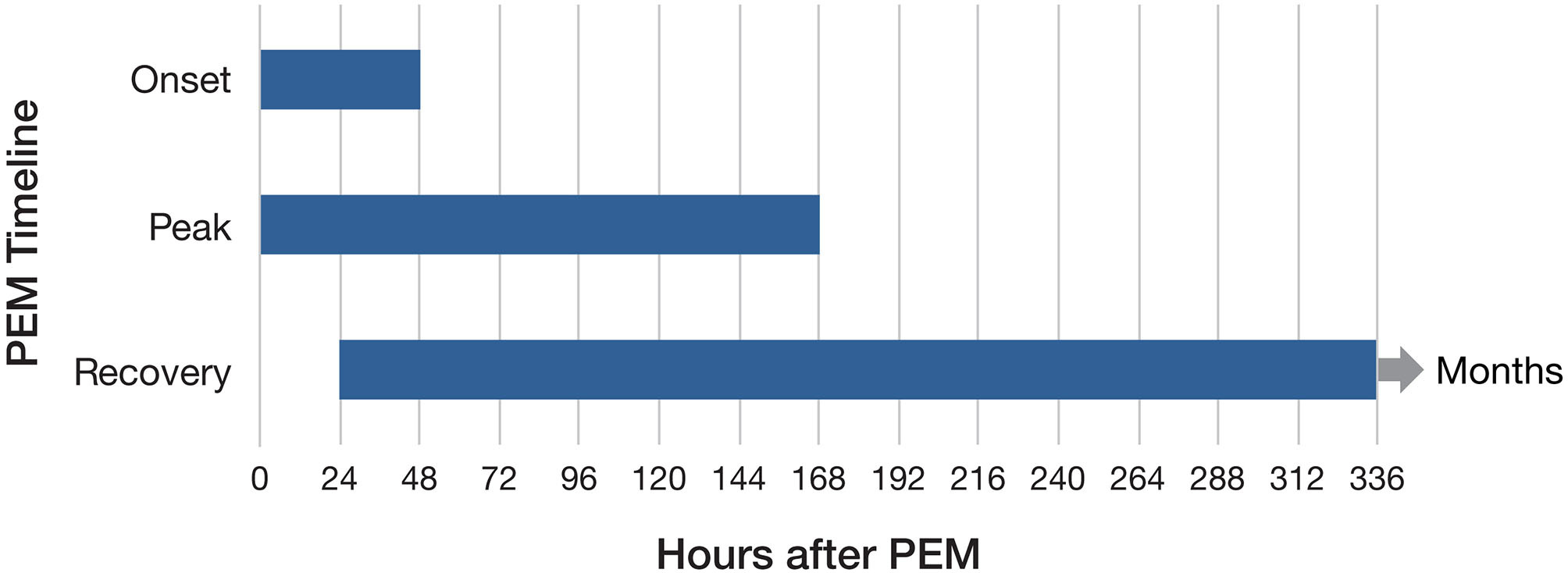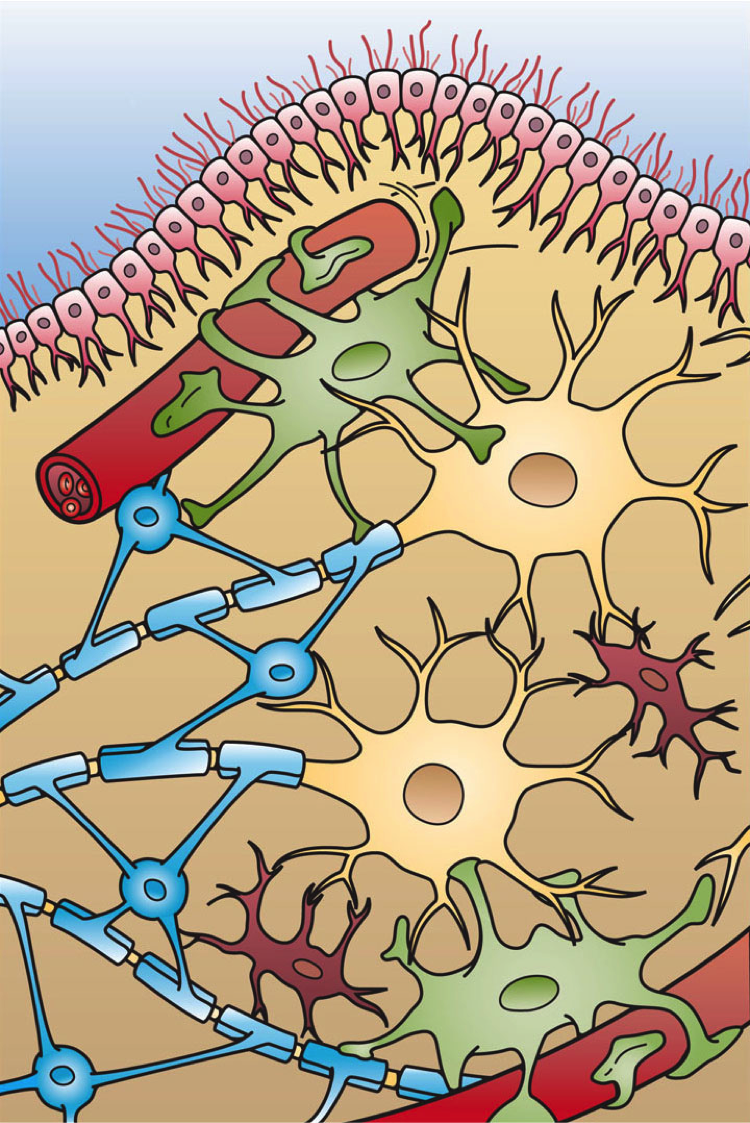|
Encephalomyelitis
Encephalomyelitis is inflammation of the brain and spinal cord. Various types of encephalomyelitis include: * '' Acute disseminated encephalomyelitis'' or ''postinfectious encephalomyelitis'', a demyelinating disease of the brain and spinal cord, possibly triggered by viral infection. * ''Encephalomyelitis disseminata'', a synonym for multiple sclerosis. * '' AntiMOG associated encephalomyelitis'', one of the underlying conditions for the phenotype neuromyelitis optica and in general all the spectrum of MOG autoantibody-associated demyelinating diseases. * '' Eastern equine encephalitis'', '' Japanese encephalitis'', '' Venezuelan equine encephalitis'', and '' Western equine encephalitis'': a group of viral illnesses that can affect horses and humans; collectively termed '' Equine encephalitis''. * ''Experimental autoimmune encephalomyelitis'' (EAE), an animal model of brain inflammation. * Progressive encephalomyelitis with rigidity and myoclonus (PERM) – A kind of stiff p ... [...More Info...] [...Related Items...] OR: [Wikipedia] [Google] [Baidu] [Amazon] |
Acute Disseminated Encephalomyelitis
Acute disseminated encephalomyelitis (ADEM), or acute demyelinating encephalomyelitis, is a rare autoimmune disease marked by a sudden, widespread attack of inflammation in the brain and spinal cord. As well as causing the brain and spinal cord to become inflamed, ADEM also attacks the nerves of the central nervous system and damages their myelin insulation, which, as a result, destroys the white matter. The cause is often a trigger such as from viral infection or, in extraordinarily rare cases, vaccinations. ADEM's symptoms resemble the symptoms of multiple sclerosis (MS), so the disease itself is sorted into the classification of the multiple sclerosis borderline diseases. However, ADEM has several features that distinguish it from MS. Unlike MS, ADEM occurs usually in children and is marked with rapid fever, although adolescents and adults can get the disease too. ADEM consists of a single flare-up whereas MS is marked with several flare-ups (or relapses), over a long per ... [...More Info...] [...Related Items...] OR: [Wikipedia] [Google] [Baidu] [Amazon] |
Chronic Fatigue Syndrome
Myalgic encephalomyelitis/chronic fatigue syndrome (ME/CFS) is a disabling Chronic condition, chronic illness. People with ME/CFS experience profound fatigue that does not go away with rest, as well as sleep issues and problems with memory or concentration. The Pathognomonic, hallmark symptom is post-exertional malaise (PEM), a worsening of the illness which can start immediately or hours to days after even minor physical or mental activity. This "crash" can last from hours or days to several months. Further common symptoms include orthostatic intolerance, dizziness or faintness when upright and pain. The cause of the disease is unknown. ME/CFS often starts after an infection, such as infectious mononucleosis, mononucleosis. It can run in families, but no genes that contribute to ME/CFS have been confirmed. ME/CFS is associated with changes in the nervous and immune systems, as well as in energy production. Diagnosis is based on distinctive symptoms, and a differential diag ... [...More Info...] [...Related Items...] OR: [Wikipedia] [Google] [Baidu] [Amazon] |
AntiMOG Associated Encephalomyelitis
MOG (myelin oligodendrocyte glycoprotein) antibody disease (MOGAD) or MOG antibody-associated encephalomyelitis (MOG-EM) is an inflammatory demyelinating disease of the central nervous system. Serum anti-myelin oligodendrocyte glycoprotein antibodies are present in up to half of patients with an acquired demyelinating syndrome and have been described in association with a range of phenotypic presentations, including acute disseminated encephalomyelitis, optic neuritis, transverse myelitis, and neuromyelitis optica. Presentation The clinical presentation is variable and largely dependent upon the overall clinical manifestation. The presence of anti-MOG autoantibodies has been described in association with the following conditions: * Seronegative neuromyelitis optica. * Acute disseminated encephalomyelitis, especially in recurrent and fulminant cases. * Multiple sclerosis. * Optic neuritis(including cases of CRION ( chronic relapsing inflammatory optic neuropathy) * Transverse myeli ... [...More Info...] [...Related Items...] OR: [Wikipedia] [Google] [Baidu] [Amazon] |
Experimental Autoimmune Encephalomyelitis
Experimental autoimmune encephalomyelitis, sometimes experimental allergic encephalomyelitis (EAE), is an animal model of brain inflammation. It is an inflammatory demyelinating disease of the central nervous system (CNS). It is mostly used with rodents and is widely studied as an animal model of the human CNS demyelinating diseases, including multiple sclerosis (MS) and acute disseminated encephalomyelitis (ADEM). EAE is also the prototype for T-cell-mediated autoimmune disease in general. EAE development was motivated by observations during the convalescence from viral diseases by Thomas M. Rivers, D. H. Sprunt and G. P. Berry in 1933. Their findings upon a transfer of inflamed patient tissue to primates was published in the '' Journal of Experimental Medicine''. An acute monophasic illness, it has been suggested that EAE is far more similar to ADEM than to MS. Types of EAE EAE can be induced in a number of species, including mice, rats, guinea pigs, rabbits and primates. ... [...More Info...] [...Related Items...] OR: [Wikipedia] [Google] [Baidu] [Amazon] |
Neuromyelitis Optica
Neuromyelitis optica spectrum disorders (NMOSD) are a spectrum of autoimmune diseases characterized by acute inflammation of the optic nerve (optic neuritis, ON) and the spinal cord ( myelitis).Banerjee S, Butcher R. Rituximab for the Treatment of Neuromyelitis Optica Spectrum Disorder nternet Ottawa (ON): Canadian Agency for Drugs and Technologies in Health; 2021 Feb. Available from: https://www.ncbi.nlm.nih.gov/books/NBK571350/ Episodes of ON and myelitis can be simultaneous or successive. A relapsing disease course is common, especially in untreated patients. * Neuromyelitis optica (NMO) is a particular disease within the NMOSD spectrum. It is characterised by optic neuritis and longitudinally extensive myelitis. In more than 80% of NMO cases, the cause is immunoglobulin G autoantibodies to aquaporin 4 ( anti-AQP4), the most abundant water channel protein in the central nervous system. * Less common diseases with other manifestations are also part of the NMOSD spectrum. S ... [...More Info...] [...Related Items...] OR: [Wikipedia] [Google] [Baidu] [Amazon] |
Multiple Sclerosis
Multiple sclerosis (MS) is an autoimmune disease resulting in damage to myelinthe insulating covers of nerve cellsin the brain and spinal cord. As a demyelinating disease, MS disrupts the nervous system's ability to Action potential, transmit signals, resulting in a range of signs and symptoms, including physical, cognitive disability, mental, and sometimes psychiatric problems. Symptoms include double vision, vision loss, eye pain, muscle weakness, and loss of Sensation (psychology), sensation or coordination. MS takes several forms, with new symptoms either occurring in isolated attacks (relapsing forms) or building up over time (progressive forms). In relapsing forms of MS, symptoms may disappear completely between attacks, although some permanent neurological problems often remain, especially as the disease advances. In progressive forms of MS, bodily function slowly deteriorates once symptoms manifest and will steadily worsen if left untreated. While its cause is unclear, ... [...More Info...] [...Related Items...] OR: [Wikipedia] [Google] [Baidu] [Amazon] |
Stiff Person Syndrome
Stiff-person syndrome (SPS), also known as stiff-man syndrome, is a rare neurological disorder of unclear cause characterized by progressive muscular rigidity and stiffness. The stiffness primarily affects the truncal muscles and is characterised by spasms, resulting in postural deformities. Chronic pain, impaired mobility, and lumbar hyperlordosis are common symptoms. SPS occurs in about one in a million people and is most commonly found in middle-aged people. A small minority of patients have the paraneoplastic variety of the condition. Variants of the condition, such as stiff-limb syndrome, which primarily affects a specific limb, are often seen. SPS was first described in 1956. Diagnostic criteria were proposed in the 1960s and refined two decades later. In the 1990s and 2000s, the role of antibodies in the condition became clearer. SPS patients generally have glutamic acid decarboxylase (GAD) antibodies, which seldom occur in the general population. In addition to blood ... [...More Info...] [...Related Items...] OR: [Wikipedia] [Google] [Baidu] [Amazon] |
Venezuelan Equine Encephalitis
Venezuelan equine encephalitis virus is a mosquito-borne viral pathogen that causes Venezuelan equine encephalitis or encephalomyelitis (VEE). VEE can affect all equine species, such as horses, donkeys, and zebras. After infection, equines may suddenly die or show progressive central nervous system disorders. Humans also can contract this disease. Healthy adults who become infected by the virus may experience flu-like symptoms, such as high fevers and headaches. People with weakened immune systems and the young and the elderly can become severely ill or die from this disease. The virus that causes VEE is transmitted primarily by mosquitoes that bite an infected animal and then bite and feed on another animal or human. The speed with which the disease spreads depends on the subtype of the VEE virus and the density of mosquito populations. Enzootic subtypes of VEE are diseases endemic to certain areas. Generally these serotypes do not spread to other localities. Enzootic subtype ... [...More Info...] [...Related Items...] OR: [Wikipedia] [Google] [Baidu] [Amazon] |
Inflammation
Inflammation (from ) is part of the biological response of body tissues to harmful stimuli, such as pathogens, damaged cells, or irritants. The five cardinal signs are heat, pain, redness, swelling, and loss of function (Latin ''calor'', ''dolor'', ''rubor'', ''tumor'', and ''functio laesa''). Inflammation is a generic response, and therefore is considered a mechanism of innate immunity, whereas adaptive immunity is specific to each pathogen. Inflammation is a protective response involving immune cells, blood vessels, and molecular mediators. The function of inflammation is to eliminate the initial cause of cell injury, clear out damaged cells and tissues, and initiate tissue repair. Too little inflammation could lead to progressive tissue destruction by the harmful stimulus (e.g. bacteria) and compromise the survival of the organism. However inflammation can also have negative effects. Too much inflammation, in the form of chronic inflammation, is associated with variou ... [...More Info...] [...Related Items...] OR: [Wikipedia] [Google] [Baidu] [Amazon] |
Equine Encephalitis
Equine encephalitis is a family of horse diseases that also affect humans. Encephalitis is an inflammation of the brain. Several forms of viral encephalitis can infect equines, and these include: * Eastern equine encephalitis virus * Japanese encephalitis virus * Venezuelan equine encephalitis virus * Western equine encephalitis virus * West Nile virus West Nile virus (WNV) is a single-stranded RNA virus that causes West Nile fever. It is a member of the family ''Flaviviridae'', from the genus ''Flavivirus'', which also contains the Zika virus, dengue virus, and yellow fever virus. The virus ... {{setindex Horse diseases ... [...More Info...] [...Related Items...] OR: [Wikipedia] [Google] [Baidu] [Amazon] |
Human T-lymphotropic Virus
The primate T-lymphotropic viruses (PTLVs) are a group of retroviruses that infect primates, using their lymphocytes to reproduce. The ones that infect humans are known as human T-lymphotropic virus (HTLV), and the ones that infect Old World monkeys are called simian T-lymphotropic viruses (STLVs). PTLVs are named for their ability to cause adult T-cell leukemia/lymphoma, but in the case of HTLV-1 it can also cause a demyelinating disease called tropical spastic paraparesis. On the other hand, newer PTLVs are simply placed into the group by similarity and their connection to human disease remains unclear. HTLVs have evolved from STLVs by interspecies transmission. Within each species of PTLV, the HTLV is more similar to its cognate STLV than to the other HTLVs. There are currently three species of PTLVs recognized by the ICTV (P/H/STLV-1, -2, -3), plus two that are reported but unrecognized (HTLV-4, STLV-5). The first known, and still most medically important PTLV is HTLV-1, ... [...More Info...] [...Related Items...] OR: [Wikipedia] [Google] [Baidu] [Amazon] |



